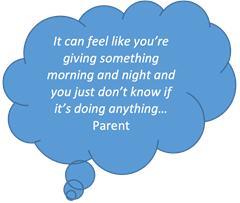Managing Childrens' Asthma at Home - Information for Parents & Carers
As a GP trainee working with Connecting Care for Children, I’ve spoken to young people with asthma and their families about their experiences with healthcare. From these conversations, I noticed that sometimes parents/carers don’t have all the information they need to manage asthma at home. To help with this, I’ve written a blog post that answers some of the common concerns families have, using real quotes from young people living with asthma and their families.
What is asthma?
Asthma is a long term condition affecting the lungs. It makes airways inflamed (narrowed) and sometimes creates more mucus than normal - this means less air gets in and out of the lungs, making it harder to breathe.
It is a very common condition - around 1 in 11 children in the UK have asthma!

For some people asthma is a life-long condition, but if it starts in childhood it can improve or even go away during teenage years. In some cases, it may come back later in life.

What are the symptoms of asthma?
Common symptoms of asthma include:
-
Wheeze
-
Cough
-
Breathlessness
-
Chest tightness
How is asthma diagnosed?
For some children, the doctor will trial medications to treat asthma.

Others will need to have some non-invasive tests. This can include:
-
Peak Flow Test: This is a small machine that tests how fast you can breathe out – this can be done in your GP Practice, or measured at home.

-
FeNO: this machine measures the level of inflammation in the lungs by measuring the amount of nitric oxide in the breath and is measured in a specialist clinic
-
Spirometry: this machine measures lung capacity and how fast you can breathe out and is measured in a specialist clinic
Asthma Medications

The goal of asthma treatment is to reduce your child’s symptoms and prevent asthma attacks. Asthma medications reduce inflammation in the lungs, which helps reduce symptoms when they are exposed to asthma triggers. They are called ‘preventer medications’ and can be in inhaler, tablet or granule form.
It is important to give your child medications as prescribed, even if they feel fine.

If you have questions or concerns about your child’s medications or treatment, speak to your GP or Pharmacist.
Personalised Asthma Plans
Every child with asthma should have a “Personalised Asthma Plan”. This is a printed document that explains your child’s asthma treatment. A Personalised Asthma Plan helps to manage their asthma symptoms at home.
It should include details about: 
-
Their current medications and when to take them
-
The triggers for their asthma symptoms
-
Signs that your child’s asthma is getting worse
-
What to do in an emergency (an asthma attack)
Here is an example of a Personalised Asthma Plan from Asthma and Lung UK:


If your child does not have an asthma plan, speak to your GP. These can be printed in other languages too.
Annual Asthma Review

Even if your child has been to the hospital this year for asthma, it is important to have a review at your GP Practice too. This helps make sure their care is joined up between the hospital and GP Practice/
Some children may need review more than once a year, depending on their symptoms.
The 2-Day Asthma Review
If your child is admitted to hospital with an asthma attack (including A&E treatment) they should have a review in your GP Practice, even if they feel better. This should be done within 2-working days of them being discharged, as this is when they may be at higher risk of another asthma attack.
At this appointment, a medical professional may:
-
Go over what led to the asthma attack, including the trigger
-
Review the treatment given in A&E or the Hospital
-
Examine your child
-
Provide more treatment if asthma symptoms are still present
-
Review your child’s regular medications
-
Update the Personalised Asthma Plan
If you are not sure how to request this appointment, have a look at this poster:

Where can I get more support as a parent/carer for a young person with asthma?

